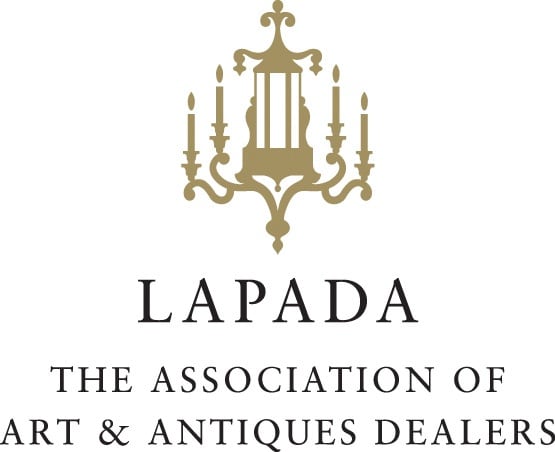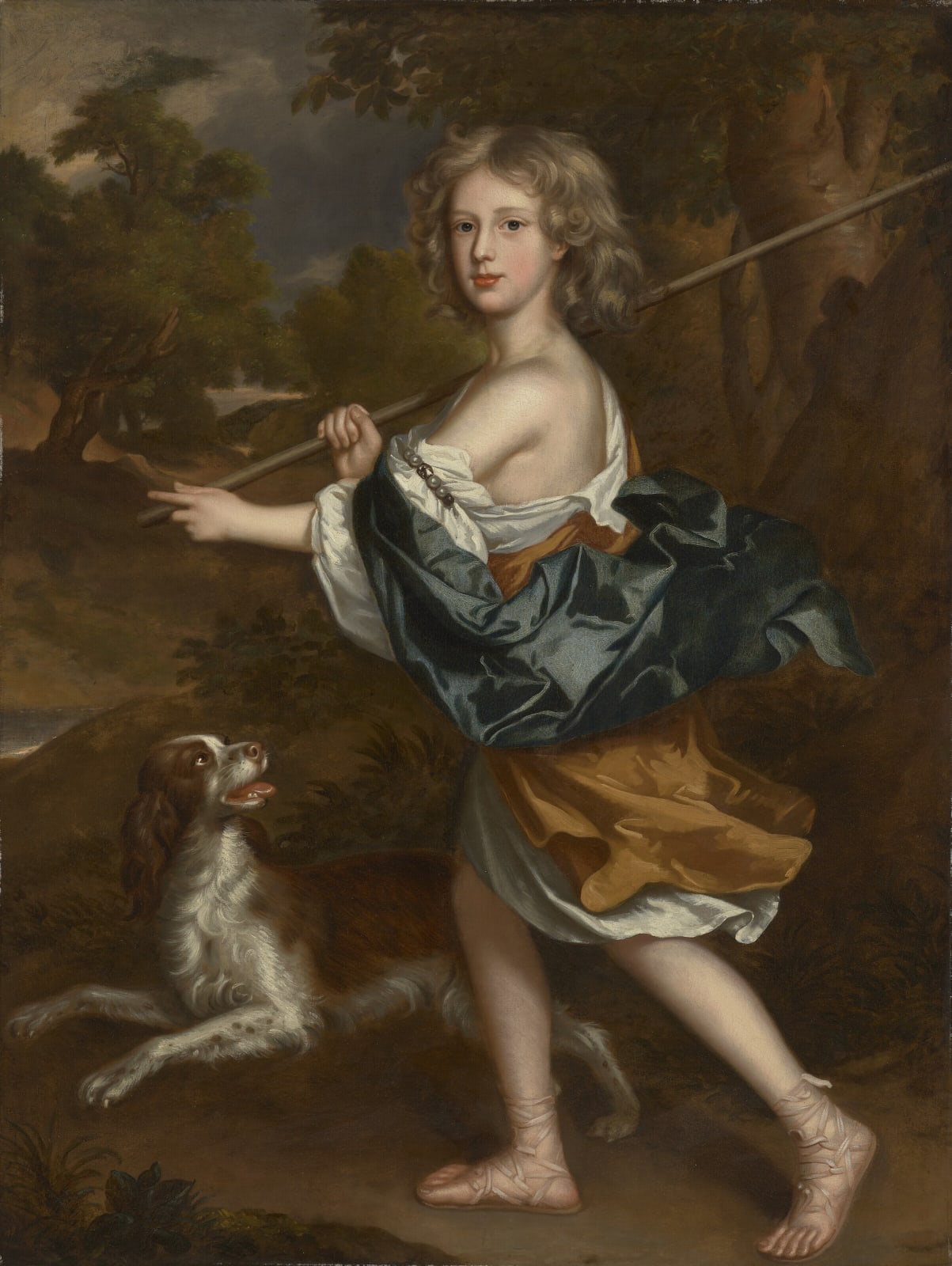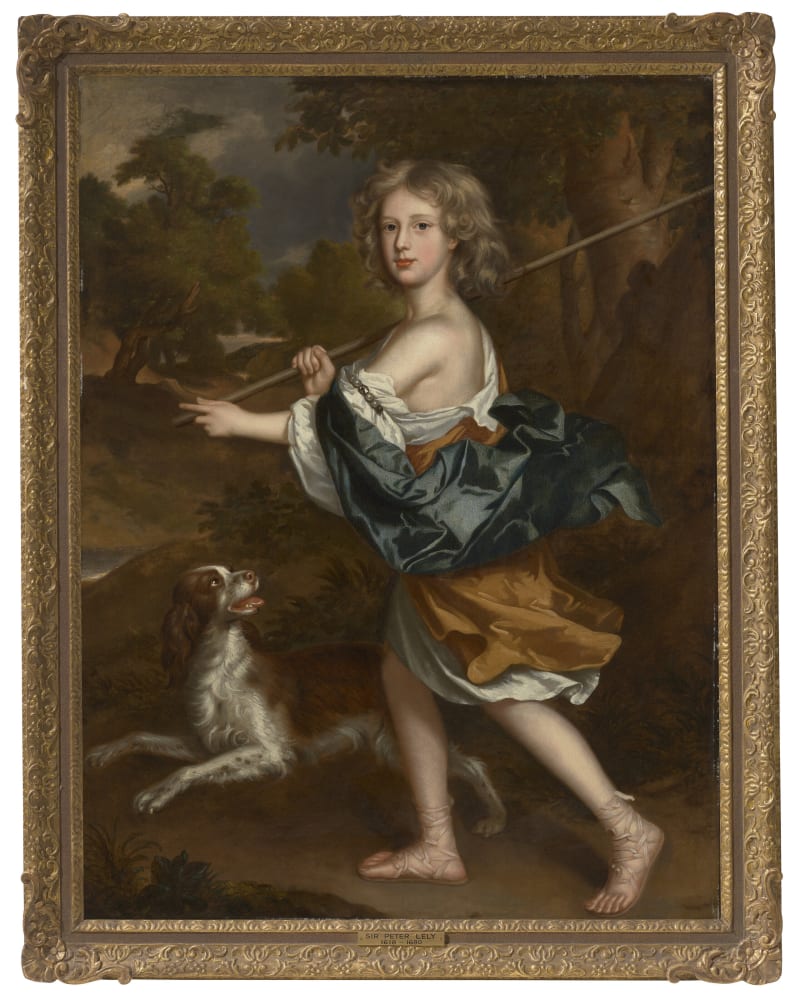Attributed to William Wissing (1656-1687) and Studio
Provenance
The Draycott House, Chippenham
With F. Newcombe, Park Street Gallery, Bristol
Anonymous sale, Christie's London, August 1st 1929, lot 98 as 'School of
Lely'
Anson (Sale: Parke Bernet Galleries, Inc., New York, February 20 1941, lot 304, as 'Lely and Studio'), purchased by H. Goldman.
Sotheby's New York, Old Master Paintings, November 11 1991, lot 48, as 'Studio of Sir Peter Lely'.
Literature
Tabitha Barber, Wissing, Willem [William] (1656–1687), portrait painter, Oxford Dictionary of National Biography. September 2004
Ellis Waterhouse, Painting in Britain 1530-1790, 1962
A portrait of a young boy in an arcadian landscape, wearing classical dress and sandals with a blue cloak, holding a spear over his shoulder, his dog running alongside him whilst gazing upwards towards his master. The boy's flowing robes suggest he is hastening to a place in the distance and he looks outwards towards the viewer, gesturing towards his intended destination.
A portrait of James, Duke of Cambridge (1663-7) in the Royal Collection follows a similar composition to this work. Originally painted for Queen Anne and recorded as being in the Queen's Drawing Room of the Garden House at Windsor in the inventory of 1710, it is now hanging in an ante-chamber at the royal palace of Holyrood in Edinburgh.
William or Willem Wissing (1656-1687), is believed to have been born in Amsterdam, He received his artistic training in The Hague as one of three pupils of Arnold van Ravesteyn (c.1650–1690), and also as the pupil of Willem Doudijns (1630–1697). He had moved to London by 1676 and most probably entered Sir Peter Lely's studio as an assistant shortly after his arrival.
Following Lely's death in November 1680, Wissing pursued a successful independent career, becoming one of the leading portraitists of the 1680s who 'drew most of the then Court, and was Competitor with Sir Godfrey Kneller, who was at the time upon his Rise' (Buckeridge, 476). A head and shoulders of the duke of Monmouth of 1683 (ex Christies, 2 February 1973, lot 80) is the earliest signed and dated portrait so far known.
Wissing produced several portraits of Monmouth and, according to Buckeridge, it was an image of the duke that 'recommended him (Wissing) to King Charles'. The portrait of Charles II (Royal Collection) probably dates to about the same time, as does Princess Anne (Royal Collection), a version of which at Cirencester Park is probably that promised to Lady Bathurst by the princess in a letter written shortly before her marriage in July 1683. Among other portraits datable to the reign of Charles II is a seated full length of Catherine of Braganza (engraved 1684), commissioned by the queen to be sent to the princess of Orange in Holland. The year 1684 is also the speculated start date of Wissing's business association with the print publisher Edward Cooper. Wissing's career coincides with the 1680s vogue for mezzotint publishing and, next to Kneller's, Wissing's works were the most widely reproduced. The vast majority, engraved primarily by John Smith, Isaac Beckett, and R. Williams, were published by Cooper, who seems to have secured a monopoly, sanctioned by Wissing, on prints after Wissing's portraits.
From 1685 until his early and unexpected death in 1687 Wissing's career was at its height. The large body of surviving works, and engravings after them, is evidence of a busy studio much in demand, providing portraits broadly in the manner of Lely (and sometimes employing Lely's poses) but with a more mannered elegance and decorative baroque formality. Wissing began employing Jan Vandervaart, as his studio assistant, for landscape backgrounds, drapery, and floral accessories and according to Vertue, served Wissing 'for many years' (Vertue, Note books,3.32). Wissing appears to have been much patronized by the new King and Queen, James II and Mary of Modena. Early in the new reign he produced portraits of both, and several versions, with varying accessories (examples in NPG; Scot. NPG, and Yale U. CBA). In 1685 the King and Queen commissioned Wissing to go to Holland to paint the portraits of the Prince and Princess of Orange respectively. The portraits, and versions of each, are in the Royal Collection.
The year 1685 is the date of Wissing's first documented association with the Brownlows of Belton and other allied Lincolnshire families, who were major patrons of his later years. The portrait of Elizabeth Brownlow (Belton, Lincolnshire), showing the sitter as a small child seated amid a profusion of flowers and other baroque accessories, dates from that year, as does the full-length of Lady Brownlow (Grimsthorpe Castle, Lincolnshire). The Hon. William Cecil, as a small child in arcadian costume on the edge of a riverbank, and John, Lord Burghley, full length in semi-classical attire, with a dog and gun, are some of Wissing's finest works ( both at Burghley House, Lincolnshire). These works typify the elaborately decorative portraits perfected by Wissing in his later years and for which he is best-known today. Mary Grimston (priv. coll.) and the double full-length Lady Frances and Lady Catherine Jones (priv. coll.) are examples using similar compositions, their subjects seated before the gardens of grand town mansions, with displays of poppies in the foreground, the latter presumably by Vandervaart and a pattern repeated in several of Wissing's works.
Wissing died on 10 September 1687 while engaged at Burghley on a group portrait of the fifth earl of Exeter and his sons, and was buried on 12 September at St Martin's, Stamford. The unfinished work was the subject of a poem by Matthew Prior, to the Right Honourable the countess dowager of Devonshire; 'The goddess Triumph'd, and the painter dy'd'.
Wissing's funeral monument in Stamford was erected by his patron, Lord Exeter. Its inscription and other near contemporary sources attest to Wissing's good character and affability. According to Buckeridge, Wissing was a man whose 'good Manners and Complaisance recommended him to most People's Esteem', and who would take his female sitters by the hand and dance them around the room, to heighten their complexions and thus their painted beauty (Buckeridge, 476). The Latin dedication below John Smith's memorial mezzotint of Wissing, after an unknown self-portrait, laments the passing of a rising genius cut short in his prime.
-

-
 ATTRIBUTED TO JOHN RILEY (1646-1691) AND JOHN CLOSTERMAN (1660-1711)Portrait of a Young Girl standing on a terrace , c.1685Oil on canvas186 x 126cm (73 x 49 1/2in)£24,000.00%3Cdiv%20class%3D%22artist%22%3EATTRIBUTED%20TO%20JOHN%20RILEY%20%281646-1691%29%20AND%20JOHN%20CLOSTERMAN%20%281660-1711%29%3C/div%3E%3Cdiv%20class%3D%22title_and_year%22%3E%3Cspan%20class%3D%22title_and_year_title%22%3E%20Portrait%20of%20a%20Young%20Girl%20standing%20on%20a%20terrace%20%3C/span%3E%2C%20%3Cspan%20class%3D%22title_and_year_year%22%3Ec.1685%3C/span%3E%3C/div%3E%3Cdiv%20class%3D%22medium%22%3EOil%20on%20canvas%3C/div%3E%3Cdiv%20class%3D%22dimensions%22%3E%20186%20x%20126cm%20%2873%20x%2049%201/2in%29%3C/div%3E%3Cspan%20class%3D%22price%22%3E%C2%A324%2C000.00%3C/span%3E
ATTRIBUTED TO JOHN RILEY (1646-1691) AND JOHN CLOSTERMAN (1660-1711)Portrait of a Young Girl standing on a terrace , c.1685Oil on canvas186 x 126cm (73 x 49 1/2in)£24,000.00%3Cdiv%20class%3D%22artist%22%3EATTRIBUTED%20TO%20JOHN%20RILEY%20%281646-1691%29%20AND%20JOHN%20CLOSTERMAN%20%281660-1711%29%3C/div%3E%3Cdiv%20class%3D%22title_and_year%22%3E%3Cspan%20class%3D%22title_and_year_title%22%3E%20Portrait%20of%20a%20Young%20Girl%20standing%20on%20a%20terrace%20%3C/span%3E%2C%20%3Cspan%20class%3D%22title_and_year_year%22%3Ec.1685%3C/span%3E%3C/div%3E%3Cdiv%20class%3D%22medium%22%3EOil%20on%20canvas%3C/div%3E%3Cdiv%20class%3D%22dimensions%22%3E%20186%20x%20126cm%20%2873%20x%2049%201/2in%29%3C/div%3E%3Cspan%20class%3D%22price%22%3E%C2%A324%2C000.00%3C/span%3E
Join our mailing list
* denotes required fields
We will process the personal data you have supplied to communicate with you in accordance with our Privacy Policy. You can unsubscribe or change your preferences at any time by clicking the link in our emails.
Old master, British and European paintings and sculpture from the 16th To 19th century


+44(0)7984 699799 CONTACT@ISHERWOODFINEART.COM
This website uses cookies
This site uses cookies to help make it more useful to you. Please contact us to find out more about our Cookie Policy.






